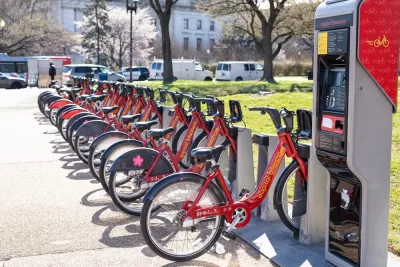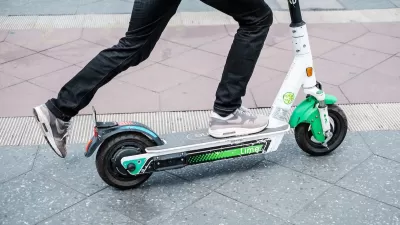Shared micromobility, particularly docked bikeshare systems, are seeing record growth, but ‘scooter inflation’ may cool riders’ enthusiasm.

U.S. bikeshare systems are bouncing back with a vengeance after the pandemic, reports Sarah Holder for Bloomberg CityLab, with systems around the country seeing ridership growth of 18 percent over 2019. “Of all the modes, docked bikeshare was most resilient, declining only 24% between 2019 and 2020 even as transit ridership plunged by 81% and car travel by 40%.” Numbers were more mixed for e-scooters, which some operators pulled from cities as ridership dropped. “Ridership nearly doubled between 2020 and 2021 to 62.5 million, making up more than half of the year’s overall micromobility users, but the number of trips was still 27% lower than in 2019.”
Even with pandemic setbacks, shared micromobility’s popularity has grown steadily. “Since the dawn of the tiny vehicle revolution in 2010, US ridership has reached half a billion total rides.”
Holder warns that despite this growth, rising prices could drive away riders. “To remain a viable transportation option for residents, however, the industry will need to get a handle on scooter inflation. No longer subsidized by a glut of investor capital, the average dockless e-scooter or e-bike ride cost $7 in 2021 — double or more than 2018 rates, making it pricier than the typical transit trip and more comparable with sharing an Uber or Lyft.”
Alex Engel, NACTO’s senior communications manager, also points to the need for safer infrastructure for bikes and scooters in many cities. “Beyond environmental or economic forces, the future popularity of micromobility will have a lot to do with how streets are designed and how systems reach riders.”
FULL STORY: Bikeshare Roars Back From the Pandemic

Study: Maui’s Plan to Convert Vacation Rentals to Long-Term Housing Could Cause Nearly $1 Billion Economic Loss
The plan would reduce visitor accommodation by 25,% resulting in 1,900 jobs lost.

North Texas Transit Leaders Tout Benefits of TOD for Growing Region
At a summit focused on transit-oriented development, policymakers discussed how North Texas’ expanded light rail system can serve as a tool for economic growth.

Using Old Oil and Gas Wells for Green Energy Storage
Penn State researchers have found that repurposing abandoned oil and gas wells for geothermal-assisted compressed-air energy storage can boost efficiency, reduce environmental risks, and support clean energy and job transitions.

Private Donations Propel Early Restoration of Palisades Playground
Los Angeles has secured over $1.3 million in private funding to restore the Pacific Palisades playground months ahead of schedule, creating a modern, accessible space that supports community healing after recent wildfires.

From Blight to Benefit: Early Results From California’s Equitable Cleanup Program
The Equitable Community Revitalization Grant (ECRG) program is reshaping brownfield redevelopment by prioritizing projects in low-income and environmental justice communities, emphasizing equity, transparency, and community benefits.

Planting Relief: Tackling Las Vegas Heat One Tree at a Time
Nevada Plants, a Las Vegas-based nonprofit, is combating the city’s extreme urban heat by giving away trees to residents in underserved neighborhoods, promoting shade, sustainability, and community health.
Urban Design for Planners 1: Software Tools
This six-course series explores essential urban design concepts using open source software and equips planners with the tools they need to participate fully in the urban design process.
Planning for Universal Design
Learn the tools for implementing Universal Design in planning regulations.
Ascent Environmental
Borough of Carlisle
Institute for Housing and Urban Development Studies (IHS)
City of Grandview
Harvard GSD Executive Education
Toledo-Lucas County Plan Commissions
Salt Lake City
NYU Wagner Graduate School of Public Service





























